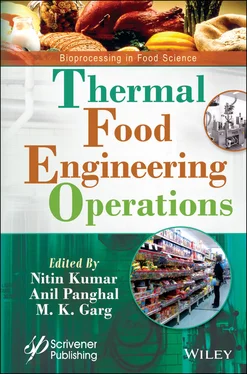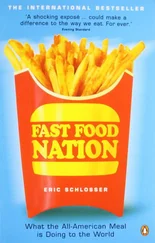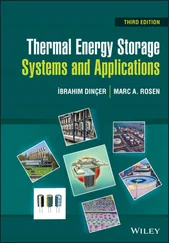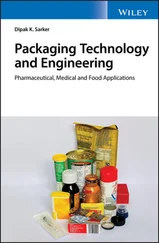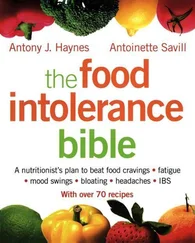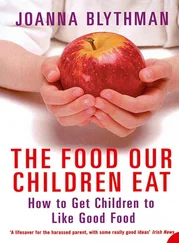NITIN KUMAR - Thermal Food Engineering Operations
Здесь есть возможность читать онлайн «NITIN KUMAR - Thermal Food Engineering Operations» — ознакомительный отрывок электронной книги совершенно бесплатно, а после прочтения отрывка купить полную версию. В некоторых случаях можно слушать аудио, скачать через торрент в формате fb2 и присутствует краткое содержание. Жанр: unrecognised, на английском языке. Описание произведения, (предисловие) а так же отзывы посетителей доступны на портале библиотеки ЛибКат.
- Название:Thermal Food Engineering Operations
- Автор:
- Жанр:
- Год:неизвестен
- ISBN:нет данных
- Рейтинг книги:5 / 5. Голосов: 1
-
Избранное:Добавить в избранное
- Отзывы:
-
Ваша оценка:
- 100
- 1
- 2
- 3
- 4
- 5
Thermal Food Engineering Operations: краткое содержание, описание и аннотация
Предлагаем к чтению аннотацию, описание, краткое содержание или предисловие (зависит от того, что написал сам автор книги «Thermal Food Engineering Operations»). Если вы не нашли необходимую информацию о книге — напишите в комментариях, мы постараемся отыскать её.
Presenting cutting-edge information on new and emerging food engineering processes,
, the first volume in the new series, “Bioprocessing in Food Science,” is an essential reference on the modeling, quality, safety, and technologies associated with food processing operations today.
This outstanding new volume:
Audience:
Thermal Food Engineering Operations — читать онлайн ознакомительный отрывок
Ниже представлен текст книги, разбитый по страницам. Система сохранения места последней прочитанной страницы, позволяет с удобством читать онлайн бесплатно книгу «Thermal Food Engineering Operations», без необходимости каждый раз заново искать на чём Вы остановились. Поставьте закладку, и сможете в любой момент перейти на страницу, на которой закончили чтение.
Интервал:
Закладка:
Table of Contents
1 Cover
2 Title Page
3 Copyright
4 Preface
5 1 Novel Thermal Technologies: Trends and Prospects 1.1 Introduction 1.2 Novel Thermal Technologies: Current Status and Trends 1.3 Types of Thermal Technologies 1.4 Future Perspective of Novel Thermal Technologies 1.5 Conclusion References
6 2 Microbial Inactivation with Heat Treatments 2.1 Introduction 2.2 Innovate Thermal Techniques for Food Reservation 2.3 Inactivation Mechanism of Targeted Microorganism 2.4 Environmental Stress Adaption 2.5 Resistance of Stress 2.6 Various Techniques for Thermal Inactivation 2.7 Forthcoming Movements of Thermal Practices in Food Industry 2.8 Conclusion References
7 3 Blanching, Pasteurization and Sterilization: Principles and Applications 3.1 Introduction 3.2 Blanching: Principles & Mechanism 3.3 Pasteurization: Principles & Mechanism 3.4 Sterilization: Principles, Mechanism and Types of Sterilization 3.5 Conclusions References
8 4 Aseptic Processing 4.1 Introduction 4.2 Aseptic Processing 4.3 Principle of Thermal Sterilization 4.4 Components of Aseptic Processing 4.5 Aseptic Packaging 4.6 Applications of Aseptic Processing and Packaging 4.7 Advantages of Aseptic Processing and Packaging 4.8 Challenges of Aseptic Processing and Packaging 4.9 Conclusion References
9 5 Spray Drying: Principles and Applications 5.1 Introduction 5.2 Concentration of Feed Solution 5.3 Atomization of Concentrated Feed 5.4 Droplet-Hot Air Contact 5.5 Drying of Droplets 5.6 Particle Separation 5.7 Effect of Process Parameters on Product Quality 5.8 Classification of Spray Dryer 5.9 Morphological Characterization of Spray-Dried Particles 5.10 Application of Spray Drying for Foods 5.11 Wall Materials 5.12 Encapsulation of Probiotics 5.13 Encapsulation of Vitamins 5.14 Encapsulation of Flavours and Volatile Compounds 5.15 Conclusion and Perspectives References
10 6 Solar Drying: Principles and Applications 6.1 Introduction 6.2 Principle of Solar Drying 6.3 Construction of Solar Dryer 6.4 Historical Classification of Solar Energy Drying Systems 6.5 Storing Solar Energy for Drying 6.6 Hybrid/Mixed Solar Drying System 6.7 Solar Greenhouse Dryer 6.8 Solar Drying Economy 6.9 New Applications Related to Solar Drying References
11 7 Fluidized Bed Drying: Recent Developments and Applications 7.1 Introduction 7.2 Principle and Design Considerations of Fluidized Bed Dryer 7.3 Design Alterations for Improved Fluidization Capacity 7.4 Energy Consumption in Fluidized Bed Drying 7.5 Effect of Fluidized Bed Drying on the Quality 7.6 Applications of Fluidized Bed Drying 7.7 Concluding Remarks References
12 8 Dehumidifier Assisted Drying: Recent Developments 8.1 Introduction 8.2 Absorbent Air Dryer 8.3 Heat Pump–Assisted Dehumidifier Dryer 8.4 Applications of Dehumidifier-Assisted Dryers in Agriculture and Food Processing 8.5 Concluding Remarks References
13 9 Refractance Window Drying: Principles and Applications 9.1 Introduction 9.2 Refractance Window Drying System 9.3 Heat Transfer and Drying Kinetics 9.4 Effect of Process Parameters on Drying 9.5 Comparison of Refractance Window Dryer with Other Types of Dryers 9.6 Effect of Refractance Window Drying on Quality of Food Products 9.7 Applications of Refractance Window Drying in Food and Agriculture 9.8 Advantages and Limitations of Refractance Window Dryer 9.9 Recent Developments in Refractance Window Drying 9.10 Conclusion and Future Prospects References
14 10 Ohmic Heating: Principles and Applications 10.1 Introduction 10.2 Basic Principles 10.3 Process Parameters 10.4 Equipment Design 10.5 Application 10.6 Effect of Ohmic Heating on Quality Characteristics of Food Products 10.7 Advantages of Ohmic Heating 10.8 Disadvantages of Ohmic Heating 10.9 Conclusions References
15 11 Microwave Food Processing: Principles and Applications 11.1 Introduction 11.2 Principles of Microwave Heating 11.3 Applications References
16 12 Infrared Radiation: Principles and Applications in Food Processing 12.1 Introduction 12.2 Mechanism of Heat Transfer 12.3 Factors Affecting the Absorption of Energy 12.4 Applications of IR in Food Processing 12.5 IR-Assisted Hybrid Drying Technologies 12.6 Conclusion References
17 13 Radiofrequency Heating 13.1 Introduction 13.2 History of RF Heating 13.3 Principles and Equipment 13.4 Applications in Food Processing 13.5 Technological Constraints, Health Hazards, and Safety Aspects 13.6 Commercialization Aspects and Future Trends 13.7 Conclusions References
18 14 Quality, Food Safety and Role of Technology in Food Industry 14.1 Introduction 14.2 Future Trends in Quality and Food Safety 14.3 Conclusion References
19 Index
20 Also of Interest
21 Wiley End User License Agreement
List of Table
1 Chapter 1 Table 1.1 Applications of Infrared heating: [1]. Table 1.2 List of some techniques combined with microwave technology.
2 Chapter 2 Table 2.1 Application of thermal techniques in food industry.
3 Chapter 3 Table 3.1 Application of different blanching methods for processing of agricultu...Table 3.2 Advantages and disadvantages of different blanching methods.Table 3.3 Application of novel thermal pasteurization techniques for the process...Table 3.4 Sterilization methods and their application in food.
4 Chapter 4Table 4.1 History of aseptic processing and packaging.Table 4.2 D value for acidic and non-acidic foods.Table 4.3 Methods for the sterilization/decontamination of the packaging materia...Table 4.4 Methods for sterilization/decontamination of packaging materials.Table 4.5 Types of food processed and packed under UHT/Aseptic Condition [14].
5 Chapter 5Table 5.1 Application of spray drying for encapsulation of various bio-active co...
6 Chapter 7Table 7.1 Typical air velocity needed for fluidization of different sized partic...Table 7.2 Comparison of fluidized beds, spouted beds and spout fluidized beds.Table 7.3 Application of fluidized bed drying in different drying studies.
7 Chapter 9Table 9.1 Energy consumption of refractance window in comparison with other drye...Table 9.2 Energy efficiency of refractance dryer when compared to other dryers [...Table 9.3 Color measurements of asparagus dried using five drying techniques [8]...Table 9.4 Color analysis for mammee apple pulp after drying using RW drying tech...Table 9.5 Carotene loss for the different drying methods [12, 17].
8 Chapter 10Table 10.1 Application and effects of ohmic heating on quality attributes of dif...Table 10.2 Effect of ohmic heating on viablity of microorganisms in different fo...
9 Chapter 11Table 11.1 Form factor b and internal electric field for some simple geometrical...
10 Chapter 12Table 12.1 Emissivity of different materials.Table 12.2 Performance characteristics of infrared emitters.Table 12.3 The depth of penetration of near-infrared rays into some food product...
11 Chapter 13Table 13.1 Comparison of RF heating with conventional and other electromagnetic ...Table 13.2 Application of radiofrequency for disinfestations, thawing, drying an...Table 13.3 Applications of radiofrequency in industrial application for bacteria...
12 Chapter 14Table 14.1 Regional effects of food quality and safety (Source: WHO).Table 14.2 Region-wise average annual growth rate of consumer spending on eating...Table 14.3 Ranking of countries with largest food and beverages market (Source: ...Table 14.4 Comparison of targeted and non-targeted analyses.Table 14.5 Food security score of select countries (Source: Economist Intelligen...Table 14.6 Codex timelines (Source: FAO).Table 14.7 List of food safety standards implemented across the global food indu...
List of Figures
1 Chapter 1 Figure 1.1 Illustration of radiofrequency heating [25]. Figure 1.2 Circuit diagram of static (batch type) resistance heating process [46...
Читать дальшеИнтервал:
Закладка:
Похожие книги на «Thermal Food Engineering Operations»
Представляем Вашему вниманию похожие книги на «Thermal Food Engineering Operations» списком для выбора. Мы отобрали схожую по названию и смыслу литературу в надежде предоставить читателям больше вариантов отыскать новые, интересные, ещё непрочитанные произведения.
Обсуждение, отзывы о книге «Thermal Food Engineering Operations» и просто собственные мнения читателей. Оставьте ваши комментарии, напишите, что Вы думаете о произведении, его смысле или главных героях. Укажите что конкретно понравилось, а что нет, и почему Вы так считаете.
